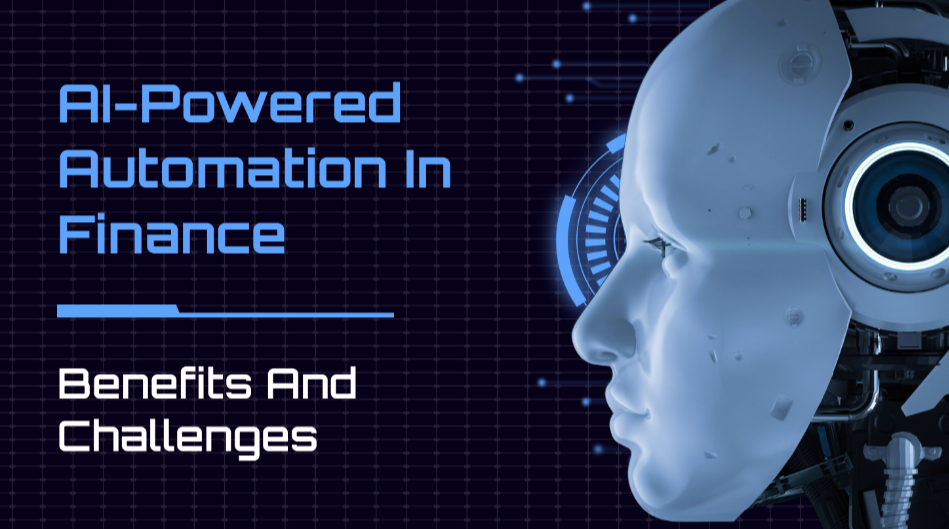The finance industry is undergoing a transformative shift with the integration of artificial intelligence (AI) and automation technologies. These advancements have redefined how financial processes are managed, delivering efficiencies, enhanced insights, and more robust risk management. While the benefits are substantial, AI-powered automation in finance also presents challenges, from data security concerns to ethical considerations. Here, we’ll explore the key advantages and obstacles of adopting AI in finance and how businesses can navigate this changing landscape.
Benefits of AI-Powered Automation in Finance
1. Increased Efficiency and Speed
One of the most compelling advantages of AI in finance is the ability to automate time-consuming and repetitive tasks. Processes such as data entry, transaction processing, and account reconciliation can now be performed much faster and with fewer errors than manual methods. AI-driven tools can analyze massive datasets, instantly delivering actionable insights that enable finance teams to make informed decisions quickly.
Example: In accounts payable, AI can automatically read, validate, and process invoices, drastically reducing the workload for finance teams.
2. Enhanced Accuracy and Reduced Human Error
Manual data entry and processing can lead to errors that impact financial outcomes. By using AI to automate these processes, companies can significantly reduce the risk of human error. AI systems are not only faster but also more accurate, ensuring data integrity and minimizing costly mistakes in reporting and compliance.
Example: AI-powered tools in tax preparation can automate calculations, ensuring accuracy and compliance with complex tax regulations, which is particularly beneficial for large corporations managing vast amounts of financial data.
3. Cost Savings
Automating finance operations can lead to substantial cost reductions. By streamlining processes and reducing reliance on manual labor, organizations can allocate resources more efficiently. In some cases, companies have reported savings of up to 50% on operational costs after implementing AI-based automation.
Example: Banks and financial institutions that have adopted AI for customer service through chatbots save on labor costs while providing 24/7 support to customers.
4. Improved Risk Management and Fraud Detection
AI is exceptional at analyzing patterns and anomalies in large datasets, making it a powerful tool for detecting fraud and managing risks. By monitoring transactions in real time, AI algorithms can identify unusual activities, helping organizations take proactive steps to mitigate potential threats.
Example: AI-driven fraud detection systems can flag suspicious transactions in banking and payment processing, alerting human analysts to investigate further and prevent financial losses.
5. Advanced Predictive Analytics
AI-powered analytics allow finance teams to forecast trends and make better-informed predictions about financial performance. Predictive models can analyze historical data and external market conditions, providing companies with valuable insights into potential opportunities and risks.
Example: Investment firms use AI algorithms to predict market trends, helping them make data-driven investment decisions that improve portfolio performance.
6. Enhanced Customer Experience
AI tools, such as chatbots and virtual assistants, enable financial institutions to provide personalized customer service around the clock. These tools can answer customer queries, assist with transactions, and offer financial advice, enhancing the overall customer experience and building trust.
Example: Chatbots in banking applications provide instant support to customers, answering common questions and guiding them through transactions without waiting for human assistance.
Challenges of AI-Powered Automation in Finance
1. Data Security and Privacy Concerns
Finance involves sensitive personal and financial data, making security a top priority. With AI systems processing vast amounts of data, there is a risk of data breaches or unauthorized access. Ensuring robust cybersecurity measures is critical, as is compliance with data protection regulations like GDPR and CCPA.
Challenge: Financial institutions need to invest heavily in secure systems to prevent data leaks and unauthorized access, as well as comply with stringent privacy laws.
2. Implementation Costs and Complexity
While AI automation can reduce costs in the long term, the initial investment for implementing these technologies can be substantial. Costs include acquiring the technology, training staff, and integrating AI with existing financial systems. Additionally, smaller companies may find the complexity of AI adoption challenging to manage.
Challenge: Organizations need to assess the ROI of AI investments carefully, especially when facing budget constraints or limited expertise.
3. Ethical and Bias Issues
AI algorithms are only as good as the data on which they are trained. If data is biased, AI-driven decisions may perpetuate those biases, leading to unfair or discriminatory practices. Financial organizations must ensure that AI systems are designed and trained responsibly.
Challenge: Companies need to audit AI models regularly to detect and eliminate potential biases, ensuring ethical practices in decision-making processes.
4. Dependence on Quality Data
AI systems rely on high-quality data to function accurately. Poor-quality data can lead to erroneous analyses and flawed financial decisions, impacting both the company and its clients. Finance teams must ensure that data inputs are accurate, relevant, and timely.
Challenge: Implementing robust data governance practices is essential to maintain data quality, which is a continuous effort that requires constant monitoring.
5. Regulatory and Compliance Issues
The use of AI in finance is still a relatively new area, and regulatory bodies are working to establish rules and guidelines. Compliance with these evolving regulations can be complex, especially for multinational organizations. Ensuring that AI systems are compliant across different jurisdictions can be challenging.
Challenge: Companies need to stay up-to-date with changing regulations and be prepared to adapt their AI practices accordingly.
6. Workforce Displacement and Reskilling
The automation of finance processes could lead to workforce displacement, as roles traditionally held by humans are taken over by AI. While AI creates new opportunities in data science, analytics, and AI management, companies must invest in reskilling employees to fill these new roles.
Challenge: Financial organizations should prioritize reskilling programs to help employees transition to AI-related roles, ensuring a smooth adjustment to an AI-driven workforce.
How to Leverage AI in Finance Responsibly
To maximize the benefits and mitigate the challenges of AI-powered automation, companies should consider the following best practices:
1. Invest in Robust Cybersecurity: Protect sensitive financial data by implementing advanced cybersecurity measures and training employees on security protocols.
2. Conduct Regular Audits: Assess AI algorithms for accuracy and fairness, ensuring compliance with ethical and regulatory standards.
3. Adopt a Phased Implementation Approach: Start small and gradually expand AI capabilities. A phased approach can help identify and address potential issues early on.
4. Prioritize Employee Reskilling: Prepare the workforce for AI adoption by offering training programs focused on digital and data skills.
5. Partner with Experts: Work with AI and finance professionals to develop and implement customized AI solutions that meet the specific needs of your organization.
Conclusion
AI-powered automation has the potential to revolutionize the finance industry, bringing unprecedented efficiencies, accuracy, and insights. By understanding the benefits and challenges, financial organizations can make informed decisions about adopting AI responsibly. With careful planning and attention to ethical practices, AI automation can be a powerful tool for financial growth and innovation, positioning companies for success in an increasingly data-driven world.
















Post Comments